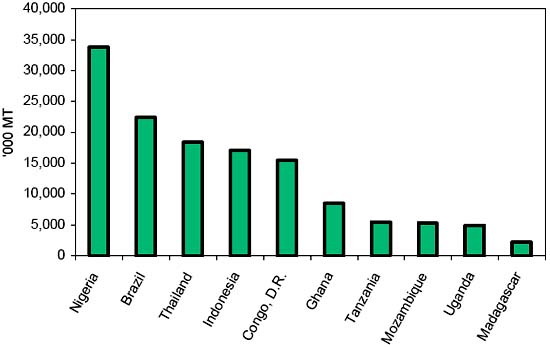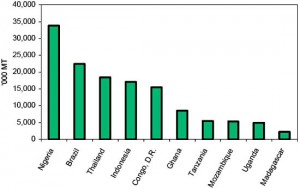The name ‘garri’ is not new to the ears of Nigerians. Garri has been around for as long as anyone can remember, and it is a major dietary source in Nigerian homes.. Though it is common among the myriad ethnic groups in Nigeria, garri is culturally associated with the Ijebu people in south west Nigeria, where the people in that area are reputed with producing fine and smooth grains known as Garri Ijebu. An attribute of the Garri Ijebu is that it has a sweet and tingling taste to the tongue. The people of Cameroun, Sierra Leone, and Ghana also consume this flaky food grain.
Sometimes spelt as ‘gari’, this staple food is derived from cassava tubers through a processing method that includes fermenting (soaking the tubers in water), grinding, and frying. Besides the popular white garri, another variation, yellow in colour, is also found in Nigeria. The yellow garri is often referred to as Garri Igbo, seemingly for the fact that Nigerians of south east origin, the Igbos, are known to consume it more than people from other geographical regions. The yellow garri is produced during processing of white garri at the frying stage by adding palm oil to the pan and stirring consistently until the grains have absorbed the oil completely.
Demand for garri is mostly high due to its affordability, ease of preparation, and the fact that it can be consumed in combination with several food items. These factors, besides a myth believed to have evolved from boarding schools over the years that garri is a life-saver, are some of the reasons why it is mostly in high demand all year round. Nigeria is reputed to be the largest producer of cassava in the world, according to a report by the Food and Agricultural Organisation, FAO. Notwithstanding this production capacity, demand for the food produce continues to increase. A cassava farmer highlighted the challenges that farmers face in attempt to ensure the availability of this grain, noting that it is sometimes almost impossible to satisfy consumers as demand always outweigh supply.
Garri processing in Nigeria, and West Africa at large, has bolstered the industry to an extent that it is now mechanized. Garri processing operations can be described at 5 levels of capacity. The levels are household (or cottage), micro, small, medium and large scales. Garri processing moved a step forward recently when the TY Danjuma Foundation commissioned a multi-million naira cassava processing plant in Ofigba, Ise Orun, Ekiti State, and in Imafon in Akure North Local Government Area of Ondo state, both in Nigeria. The cassava plant is expected to generate an estimated N3.2million naira revenue monthly for the women in the communities with a prospect of exporting the products. Ms. Thelma Ekiyor, Executive Director, TY Danjuma Foundation, said that her organisation is devoted to empowering Nigerian women, predominantly the less privileged in the society, so they can be of good support to their families.
The cassava processing plant project is not only targeted at improving the entrepreneurial capabilities of these women but also to put them on a global scale in terms of business, exporting their products outside Nigeria. The project is being coordinated by the Centre for Women and Children’s Development, CWCD.
Interesting Facts About Garri
- Though garri is widely consumed in Nigeria, it is ranked second in consumption rate in the country.
- Garri typically comes in white or golden white colour depending on the nature of the tuber from which it is processed. The yellow garri, on the other hand, is a derivative of the white one which is achieved by mixing palm oil during the frying stage.
- Machines are used in processing garri. There was a time, however, when the processing was done manually. The root shavings or mash are stuffed into bags (porous enough to allow the passage of water), pressed under heavy weights for three to five days until the moisture and starch have been drained away. The dried cassava shavings are then sieved and then either dry roasted or fried with a little palm oil in a bowl. The resulting dry granular garri can be stored and used as required.
- Cassava is high in cyanide, so the fermentation process reduces that. Besides the colour change and the additional flavour it gives to the shavings, palm oil is also useful in further lowering the cyanide content in the cassava.
- Garri is judged by its taste and grain size. The sweeter types with finer grains are valued over sour, large-grained types. Garri Ijebu is made to have finer grains, and a pleasantly sour taste, making it a favourite across Nigeria. This variation is produced mainly by Yorubas of Ijebu origin, in Nigeria.
- Garri can be served in different ways for different meals. For a complete meal, it is usually cooked by adding to hot water and manipulated into dough, known as ‘Utara’, or ‘Eba’. It is normally eaten with soups of different types of thick, leafy vegetable soups, melon seed soup (Egusi), Peanut soup (Groundnut) soup etc. Garri can also be soaked in water and combined with coconut, tiger nuts, cashew nuts, moin-moin, groundnuts, or smoked fish and sugar. Garri eaten with soft cooked beans and palm oil is another tantalizing delicacy for many.
Food security is vital to economic growth. Support the movement.




